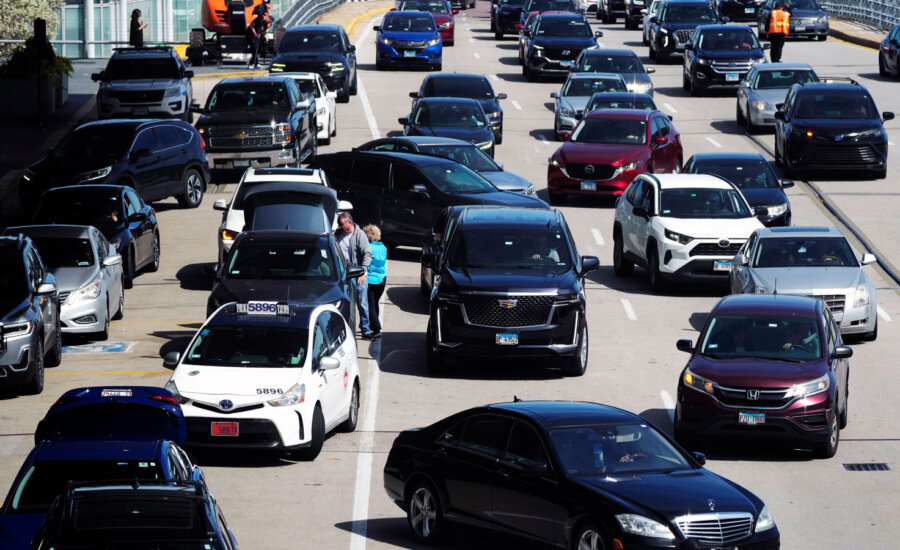Why car insurance premiums are rising and what to do about it
Surging auto insurance rates squeeze drivers, fuel inflation.
Advertisement
Surging auto insurance rates squeeze drivers, fuel inflation.

Relentlessly rising auto insurance rates are squeezing car owners and stoking inflation. American auto insurance rates rose 2.6% in March and are up 22% from a year ago. And, premium costs have been marching steadily higher since 2022, even as inflation at the consumer level steadily cooled from its 9.1% peak in the middle of that year.
U.S. consumers have had some relief as the rate of cost increases for food and energy, two key components of most budgets, has eased greatly. But auto insurance and car ownership costs have become a sticking point for consumers and the U.S. Federal Reserve in its battle to rein inflation back to its goal of 2%.
Typically, individuals would see a noticeable increase in their premiums because of speeding tickets and other moving violations. Adding new drivers or a general increase in claims in the area were other reasons. But the persistent rise in rates over the last two years has been far more sweeping. New vehicle prices starting spiking during the pandemic, mainly because of a worldwide shortage of computer chips amid production cuts and supply chain bottlenecks. Dealers spent much of 2021 with few or no cars in stock. (Read about the best used cars in Canada?)
Car price increases eased heading into 2024, with the average at USD$47,338 in January, down from a peak of USD$48,516 in late 2022, according to Edmunds.com. (All figures in U.S. dollars.)
Higher value for cars, along with more advanced technology and intricate parts, has raised the overall cost of repairs. Overall maintenance and repair costs jumped 8.2% in March from a year ago, according to the U.S. Bureau of Labor Statistics. That’s eased a bit over the last year. The rate of increase was as high as 14.2% in early 2023.
“The severity is really the thing that has influenced rates more over the last two years than anything,” said Greg Smolan, vice president of insurance operations at AAA Northeast. “A fender bender in the past didn’t have all the sensors and cameras.”
Higher overall auto prices and auto repair costs prompted insurers to start raising premiums as overall car values jumped. Price increases for insurance rates, like many other increases from food to clothing, have been sticky and are less likely to drop at the same rate as broader inflation, if at all.
That has been beneficial for insurers who have seen profits surge. Wall Street is expecting bigger leaps in 2024.
“Our sole concentration last year was to get the right rate,” said Progressive CEO Tricia Griffith, during a fourth-quarter earnings conference call. “We feel like we’re in a really great position now.”
Progressive’s profit jumped 50% and its revenue surged nearly 18% to $62.1 billion in 2023. Wall Street expects its profit to skyrocket nearly 80% in 2024 on a 14% jump in revenue. Allstate reported a modest profit in 2023 after reporting a loss a year earlier. Wall Street expects its profit to surge 13-fold as revenue rises 10% to $62.9 billion in 2024.
“Companies are getting a lot closer to rate adequacy now,” Smolan said. “I think you’ll see some flattening out of the real large increases.”
The process of obtaining auto insurance can be confusing and overwhelming, considering the differing mix of requirements in each state, extra options and the confusing industry and legal jargon used by insurers. The first step for many should be gaining a better understanding about auto insurance, according to the Insurance Information Institute.
In under five minutes, compare personalized auto insurance quotes from Canada’s top providers.
Consumers should shop around by getting at least three different quotes and from different types of insurance companies. Also, comparing costs before buying a car could help give consumers a better sense of the true cost of owning a specific car. Premiums are based in part on a car’s price, along with prospective auto repair costs and safety data.
Deductibles could be a major factor in determining monthly premium costs. That’s the amount of money that a driver is responsible for paying toward a claim. Higher deductibles usually mean lower premiums.
Bundling multiple policies under one insurer could come with a discount. This is common for homeowners using the same company for their home and auto policies. There may also be discounts for insuring more than one vehicle under the same company.
Defensive driving courses also help give drivers discounts on insurance. The timing and standards vary by state, but courses are usually offered in-person and online. Companies including Progressive and Geico often offer multi-year discounts for taking such a course. They can usually steer policy holders toward reputable companies offering the course and certificate.
Share this article Share on Facebook Share on Twitter Share on Linkedin Share on Reddit Share on Email
My car insurance tripled because what they say is a chargeable claim surcharge.I dont have any claims or accidents so my question is why and who protects the consumer when they tell you your rates will come down but they keep rising and your almost better off driving without insurance.But that’s a crime.but stealing money for greed goes unpunished
I THINK AND HOPE THAT THE GOVERNMENT SHOULD STEP IN AND REGULATE
INSURANCE FOR CARS AND HOUSES EVEN THOUGH ALL SORTS OF
DISASTER DOES MAKE INSURANCE GO UP BUT A LIMIT SHOULD BE
PUT ON BY THE CANADIAN GOVERNMENT BECAUSE IF NOT THE
PREMIUMS WILL GO SKY UP TKS
One factor that should be highlighted is the increase in collisions. As people fail to follow posted speed limits, or the province increases the limit, accidents are more common, destructive and deadly.
Insurance works when we all pay into it, but it can’t when governments fail to implement measures to make our lives safer.